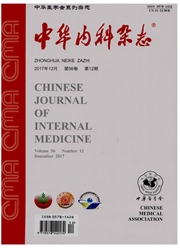

 中文摘要:
中文摘要:
目的 探讨血糖波动对抵抗素的影响.方法 比较间歇性高糖和持续性高糖对人U937单核/巨噬细胞抵抗素分泌的影响;比较糖耐量正常组(NGT组,30例)、糖耐量受损组(IGT组,31例)和新诊断2型糖尿病组(T2DM组,31例)间口服葡萄糖耐量试验1 h血糖增幅(△Glu1-0)和血清抵抗索增幅(△lnRes1-0)的差异.结果 对照组、持续性高糖组和间歇性高糖组的抵抗素分泌水平分别为(73.62±5.07)ng/L、(97.78±7.00)ng/L、(212.49±28.81)ng/L,间歇性高糖组显著高于其余两组(P〈0.05).NGT、IGT和T2DM组的△Glu1-0依次增大(P〈0.05),分别为(2.31±2.30)mmol/L、(5.70±2.08)mmol/L、(8.41±2.63)mmol/L;其△InRea1-0分别为(0.05±0.05)μg/L、(0.25±0.04)μg/L、(0.37±0.03)μg/L,T2DM组显著大于NGT组(P〈0.05).△lnRes1-0与△Glu1-0呈正相关(r=0.23,P=0.02).结论 血糖波动促进单核/巨噬细胞分泌抵抗素,血糖波动幅度越大,血清抵抗素升高幅度越大,因此,对糖尿病控糖治疗,应注意减少血糖波动.
 英文摘要:
英文摘要:
Objective To explore the effect of glucose fluctuation on resistin. Methods The phorbol-12-myristate-13-acetate(PMA)-activated and differentiated U937 cells were exposed to experimental condition for 3 days, three groups of cells were formed, each one receiving the following fresh medium every 6 hours, respectively: (1) continuous 11.1 mmol/L glucose concentration medium (Con group), (2)continuous 22.2 mmol/L glucose concentration medium (CHG group), (3) alternating 11.1 mmol/L glucose concentration and 22. 2 mmol/L glucose concentration medium every 6 hours (IHG group). The supernatants of cell mediam at the last 6 hours were collected to test resistin concentration. Besides, 92 subjects were selected and classified into three groups according to the results of oral glucose tolerance test:normal glucose tolerance group ( NGT group, n =30), impaired glucose tolerance patients (IGT group, n =31) and newly diagnosed type 2 diabetes patients (T2DM group, n =31). Blood glucose and serum resistin levels were measured at 0 h and 1 h during oral glucose tolerance test ( OGTT) to compare the glucose fluctuation (△Glu1-0) and the change of serum resistin level (△lnRes1-0) among the three groups. Results Resistin concentration in the Con , CHG and IHG group was (73.62 ± 5.07)ng/L, (97.78 ±7.00)ng/L and(212.49 ± 28. 81 )ng/L respectively and in IHG group it was higher as compared with the other two groups (P〈0.05). △Glu1-0 in NGT, IGT and T2DM group was(2.31 ±2.30)mmol/L,(5.70 ±2.08)mmol/L and (8.41 ±2.63)mmol/L respectively; △Glu1-0 increased gradually in all the three groups (P〈0.05). Serum resistin level from 0 h to 1 h in the NGT group was 6.41 (1.52-15.76) μg/L to 6. 96( 1.52-22. 70) μg/L, in the IGT group 5.47( 1.49-24. 09)μg/L to 9. 12( 1.27-21.94)μg/L and in the T2DM group 5.77( 1.11-30.10) μg/L to 9. 27(1.02-48.15)μg/L In the IGT and T2DM group serum resistin level increased from 0
 同期刊论文项目
同期刊论文项目
 同项目期刊论文
同项目期刊论文
 期刊信息
期刊信息
